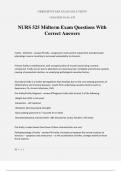©BRIGHTSTARS EXAM SOLUTIONS
11/16/2024 10:16 AM
NURS 525 Midterm Exam Questions With
Correct Answers
Frailty - definition - answer✔Frailty - progressive multi-system impairment and decreased
physiologic reserve resulting in increased vulnerability to stressors.
Primary frailty is multifactorial, with sarcopenia (loss of muscle mass) being a central
component. Frailty occurs due to alterations in neuromuscular, metabolic and immune systems
causing a homeostatic decline; no underlying pathological causative factors.
Secondary frailty is a similar dysregulation that develops due to the core wasting processes of
inflammatory and immune diseases.; results from underlying causative factors (such as
depression, CA, chronic infections, CHF)
Pre-frailty/Frailty Diagnosis - answer✔Diagnose Frailty with at least 3 of the following:
Weight loss (≥5% in last year)
Exhaustion - self reported
Weakness (decreased grip strength)
Slow walking speed (>6 to 7 seconds for 15 feet)
Decreased physical activity (males <383 kilocalories, kcals); females <270 kcals)
Pre-frailty is when fewer than three of these characteristics are met.
Pathophysiology of frailty - answer✔In frailty, the balance between the normal reaction to
stressors -- apoptosis and senescence -- or the acceleration of either, changes mainly in these
three systems:
1|Page
, ©BRIGHTSTARS EXAM SOLUTIONS
11/16/2024 10:16 AM
Musculoskeletal: Decrease in skeletal muscle mass, VO2 max, strength and exercise tolerance,
thermoregulation, energy expenditure, resting metabolic rate and muscle innervation.
Immune: There is a decrease in immunoglobulin G (IgG), IgA, interleukin 2 (IL-2) and mitogen
response. There is an increase in IL-6, IL-10 and C-reactive protein (CRP).
Neuroendocrine: decrease in growth hormone, insulin-like growth factor 1, vitamin D, estrogen
and testosterone (DHEA-S). Increase in insulin resistance, cholecystokinin, sympathetic tone
and steroid dysregulation.
Risk factors for frailty - answer✔Physiologic: activated inflammation; immune system
dysfunction; anemia; endocrine alteration; underweight or overweight; advanced age
Medical Illness/Comorbidity: CV disease; DM; CVA; arthritis; COPD; cognitive
impairment/cerebral changes
Socioeconomic and Psychological: females; low SES; race/ethnicity; depression
Disability: Dependence with ADLs
ADAM questionnaire - answer✔Assesses for presence of androgen deficiency in aging males
Timed Up and Go (TUG) Test - answer✔evaluates ability to get up from armed chair and walk
10 feet and back; Normal=<10 sec
Tinetti Assessment Tool - answer✔Assesses gait and balance
Fulmer SPICES - answer✔Fulmer SPICES is a framework for assessing older adults that focuses
on six common "marker conditions": sleep problems, problems with eating and feeding,
incontinence, confusion, evidence of falls, and skin breakdown. These conditions provide a
snapshot of a patient's overall health and the quality of care. The SPICES assessment, done
regularly, can signal the need for more specific assessment and lead to the prevention and
treatment of these common conditions.
15 second FRAILTY screening tool - answer✔Fatigue: Are you fatigued?
2|Page
, ©BRIGHTSTARS EXAM SOLUTIONS
11/16/2024 10:16 AM
Resistance: Do you have difficulty walking up one flight of steps?
Aerobic: Are you unable to walk at least one block?
Illness: Do you have more than five illnesses?
Loss of weight: Have you lost more than 5% of your weight in the past 6 months?
FACIT Fatigue Scale - answer✔Functional Assessment of Chronic Illness Therapy: evaluates
patient's perception of energy level, fatigue, and exhaustion
KATZ Index - answer✔assesses capability of performing ADLs
Lawton Scale - answer✔assesses capability of performing IADLs - use of telephone, shopping,
food prep, housekeeping, laundry, transportation, meds, finances
Pittsburgh Sleep Quality Index - answer✔Assesses sleep patterns and effectiveness
Epworth Sleepiness Scale - answer✔Screens for presence of daytime sleepiness
Hendrich II Fall Risk Model - answer✔provides a determination of risk for falling based on
gender, mental and emotional status, symptoms of dizziness, and known categories of
medications increasing risk.
DIAPPERS (causes of transient urinary incontinence) - answer✔Delirium
Infection (e. g., urinary tract infection)
Atrophic urethritis or vaginitis
Pharmacology (e.g., diuretics, anticholinergics, calcium
channel blockers, narcotics, sedatives, alcohol)
Psychological disorders (especially depression)
Endocrine disorders (e.g., heart failure, uncontrolled diabetes)
Restricted mobility (e.g., hip fracture population, environmental
3|Page
, ©BRIGHTSTARS EXAM SOLUTIONS
11/16/2024 10:16 AM
barriers, restraints)
Stool Impaction
TOILETED (causes of transient urinary incontinence) - answer✔Thin, dry vaginal and urethral
epithelium
(Atrophic urethritis or vaginitis)
Obstruction (Stool Impaction/Constipation)
Infection
Limited mobility (Restricted mobility)
Emotional (Psychological, Depression)
Therapeutic medications (Pharmacological)
Endocrine disorders
Delirium
CAM (Confusion Assessment Method) - answer✔enables non-psychiatrically trained clinicians
to identify and recognize delirium
Falls Efficacy Scale - answer✔measures the level of concern about
falling during social and physical activities inside and outside the home whether or not the
person actually does the activity; This may cause curtailment of activities, leading to reduced
mobility and physical fitness, and increasing risk of falling and injury
Sarcopenia - answer✔the age-related loss of muscle mass, strength and function; appears to
begin in the fourth decade of life and accelerates after the age of approximately 75 years; With
aging and inactivity, the most atrophy is seen in the fast twitch (FT) fibers which are recruited
during high-intensity, anaerobic movements; when lean muscle mass is less than 2 standard
deviations of gender specific mean in young healthy sample
Meds that cause edema - answer✔Antihypertensives:Hydralazine, Minoxidil, Methyldopa,
Calcium Channel Blockers (e.g. Amlodipine), Beta Blockers, Clonidine (Catapres)
Nonsteroidal Antiinflammatory Drugs (NSAIDs): Ibuprofen,Celecoxib
4|Page




